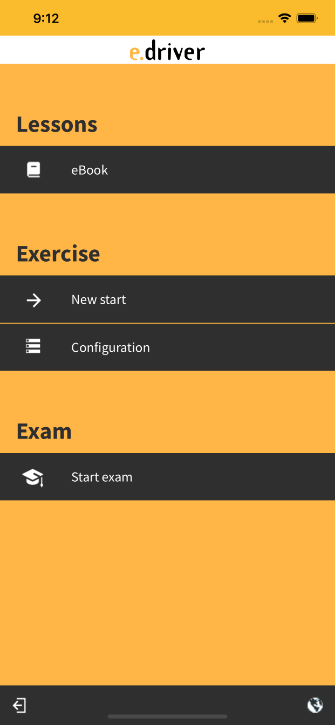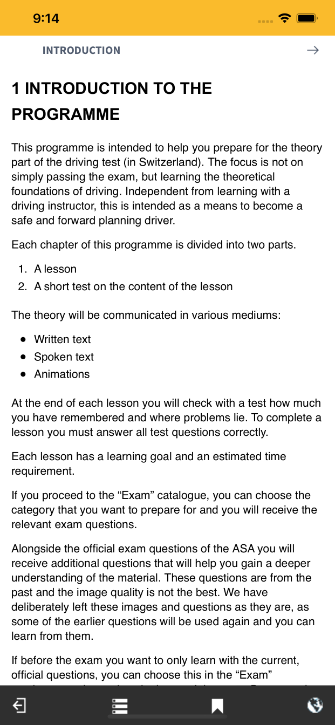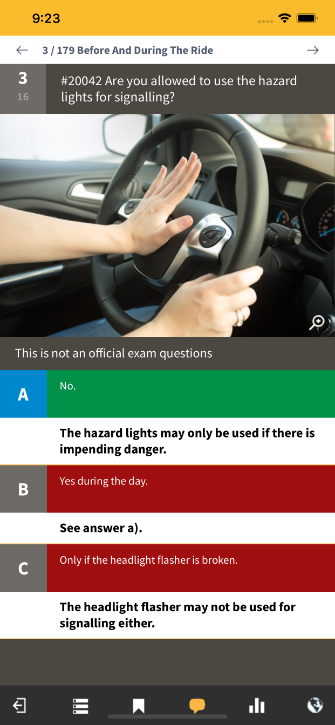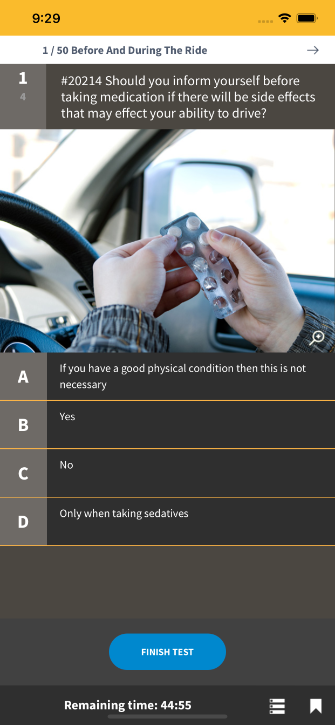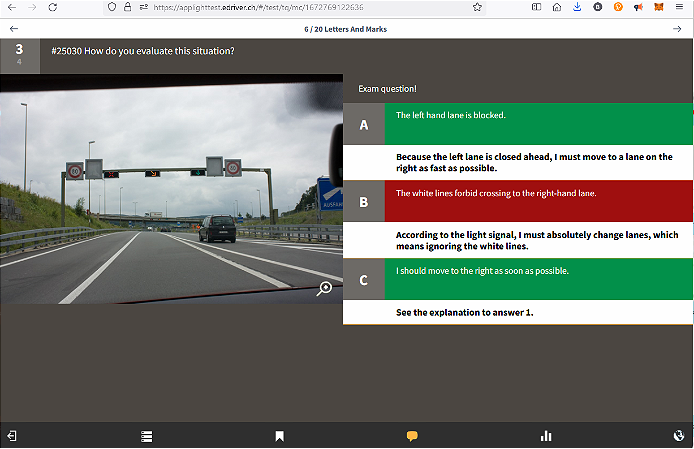e.driver theory test for cars, motorbikes, scooters, moped, tractors and construction vehicles
Preparation for the Swiss car theory test for motor vehicle drivers Cat. A1, A, B, M, F and G, available in English, German, French and Italian. As the first and only learning programme for the theory test, it includes audio, visual and practical components. Learning online for the driving theory test has been made easy.
Below are some demo questions from e.driver. Just click on a question to show possible answers.
- Question 1 - Must you give right of way to trams when they turn from a secondary road to a main road?
a) Trams always have right of way
b) Only when they come from the right.
c) No.
Correct answer: c)
Even if in principle trams always have the right of way (because they cannot move and they have difficulty braking) there is an exception, when a tram is coming from a secondary road it must give way to vehicles on the main road. Such situations are regulated by light signals
- Question 2 - In what situation must the driver with right of way give it up?
a) Never
b) If there is an indication that the driver without right of way will act incorrectly
c) Only if a lorry is approaching
Correct answer: b)
One must never insist on right of way.
- Question 3 - What safety measures are necessary before reversing?
a) One must watch out for children, pedestrians and any hinderances.
b) One must halt the oncoming traffic
c) One must always give a warning signal
Correct answer: a)
Nothing and no one is allowed to be in the danger area.
Customers have access to all language versions (EN, DE, FR, IT). In English, the following are currently available online:
- Lessons
- Test questions (translated from the original German version of the Department of Transportation)
Get Confidently Through the Driving Theory Test Thanks to
- The official test questions of the Department of Transport
- Expert commentary on the official test questions and 700 further test questions, making learning online for the theory exam easy!
- Windows and smartphone app (iPhone/iPad, Android, Windows Phone) for all test questions. Learn easily on the go.
- eBook lessons for desktop, tablets and smartphones
- Online expert forum: ask questions and get answers from experts
- Multimedia car theory lessons with spoken text
- Adaptive learning system
- Success guaranteed
Learn for the Swiss Driving Theory Test Online
Up to date original questions of the car theory test from the ASA (Association of Departments of Transport). All questions have commentary from test experts and the answers are explained. Over 15 months free access to the expert forum to ask driving instructors questions. The adaptive learning system is the optimum way to train. Effective and comprehensively learn for the Swiss driving theory exam. According to Sebastian Leitner’s adaptive learning system, harder questions are asked more frequently, depending on understanding. Available online over the web and as an app (iPhone/iPad, Android, Windows Phone).
Lessons
The Swiss driving theory exam is explained with an attractive, multimedia method. Furthermore, you can have the texts of the theory lessons read to you. Every one of the 13 lessons is conclude with a test to check how much has been learned. The lessons are also available as an eBook for iBook (iPhone, iPad), CoolReader (Android) and freda (Windows Phone).
Sucess Guaranteed
If you fail the driving theory test despite getting a score of 90% correct answers when using e.driver, we guarantee a complete refund within 120 days of purchase.
*Alternatively you can also upgrade to the newest test questions for free, if you have not passed the driving test within 15 months. This can be done up to 3 years after purchase.
- > Links
When must the distance to the vehicle in front be increased?
Understanding when to increase the distance to the vehicle in front is an important part of preparing for the driving test. Safe following distances are essential to avoid accidents, especially in situations where the risk level is elevated.
For instance, if the driver ahead is behaving unpredictably, you should anticipate sudden braking. Additionally, the faster you are driving, the more space you need to maintain — a principle often emphasized during the driving test.When should you avoid overtaking?
Overtaking other vehicles is a common situation in road traffic. When preparing for the driving test, you’ll encounter several questions on this topic. In some situations, you should definitely avoid overtaking — for example, when the vehicle in front is already travelling at the maximum permitted speed and you’d have to exceed that speed to pass, or if you’re about to make a turn, as overtaking would be pointless in that case. The same principle applies in heavy traffic queues, where overtaking doesn’t achieve much and only involves unnecessary risks.
Which lights should be used in a well-lit tunnel?
In a tunnel, even if it is well lit, you must switch on your dipped headlights. Using high beams could dazzle other road users.
Driving in tunnels and using the various vehicle lighting systems are important topics for the driving test and are covered in detail in our e.driver learning software, both in the test questions and in the theory lessons.Which lights should you use in foggy conditions?
In autumn, fog can often appear on certain stretches of road. If you’re studying for your driving test or already have your licence, you may wonder which lights to use when fog occurs during the day.
In this situation, you must also switch on your dipped headlights during the day.
High beams, on the other hand, should only be used at night – and only when they won’t dazzle other road users.- drivers-license
- driving-license-test
- driving-license-theory
- driving-license
- driving-school-geneva
- driving-school
- driving-test-questions
- driving-test
- driving-theory-test
- driving-theory
- swiss-driving-license
- swiss-driving-school
Driving test
Driving test
